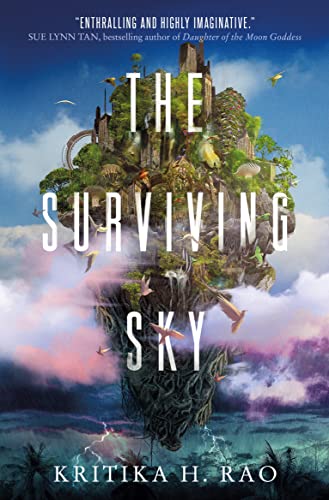Having been blogged out, read out, burned out and whatever else I can think of as down and out recently, I was determined to give myself a long summer break, determined that is until I picked up The Surviving Sky by Kritika H. Rao. I could not put this debut novel down. The powerful clash and love of its two central characters, Iravan and Ahilya, drew me in from their first staring match right through to the end. They are forever storming in anger or love, torn apart, furiously repulsed then magnetically drawn together, broken and remade, yet they are always compelling characters, and the survival of their world just happens to depend on them.
The world of The Surviving Sky is post-apocalyptic, subject to incredibly violent upheavals, called earthrages, and dominated now by giant creatures called yakshas, that closely resemble familiar large mammals, like elephants and tigers, but on a massive scale. The upheavals drove the human inhabitants to find a way to create cities that float in the sky. Flight was possible due to an innate skill possessed only by a few powerful figures called architects. They have the power of trajection, by which they can see the inner structure of the world, perceive the consciousness of plants and people and manipulate the growth patterns that shape the city. Here is an early example of Iravan’s dual vision that takes him into the Moment and a fundamentally different perception of reality.
“Within his second vision, he existed as a dust mote suspended in an infinite universe. Golden lights gleamed in every direction, endless and breathtaking. The universe was the Moment: a motionless reality reflecting the consciousness of the plants that comprised the building blocks of Nakshar. Each frozen star in the Moment was a plant’s possible state of being. Infinite such states existed for every plant, yet Iravan knew each one as well as he knew himself.
The Surviving Sky, Kindle edition, Locations 509-518
….
Iravan smiled. This was something that non-architects could never understand. Nakshar’s living architecture was more than just a maze of plants. It was the intersection of lives, of promises, of intent. It was elegance and beauty and harmony.”
There are many cities, but the story’s focus is on Nakshar. While flying, the city spreads out among many acres, but during a lull in the earthrages when it is safe to land, the architects reshape it, drawing everything into an ellipsoidal structure around the great rudra tree, site of the temple at the heart of community life. This is the shape of Nakshar at the opening of The Surviving Sky, as it prepares to land after seven long months of an especially intense earthrage.
During that seven months, Iravan, as a senior architect and member of the ruling council, has been working overtime in trajection and has not once taken time to visit his wife Ahilya. They had quarreled and parted in anger, and Iravan had no inclination to make the first move toward reconciliation. But neither does Ahilya, an archeologist whose work is all about exploring the possibility of re-establishing settled life on the earth surface. She is determined to prove the architects wrong in their view of the planet as a lost cause, but Ahilya believes that is simply because they want to maintain their power. So the relationship between Iravan and Ahilya comes to embody that larger clash as well as their personal tensions.
Both are stubborn and gifted, but Iravan has all the power of the architect ruling class on his side, while Ahilya can only hope that they will make room on the council for an archeologist some day. She is desperate to prove her theories and challenge the power of the architects, but she is also deeply in love with Iravan, as he is with her. Their efforts to get back together are almost always frustrated, either by the clash of their strong wills or by the tensions about the work they do, in their opposing ways, to make life better.
As Nakshar is about to land and the families of the architects gather around the rudra tree to embrace their loved ones, Ahilya on a balcony, dressed in rough work clothes and impatient to start her latest expedition on the surface, only stares at Iravan. Neither make a move toward the other, and Ahilya finally turns to join her companions to venture into the jungle. That is emblematic of their relationship throughout the story. Even when one of them makes a move to re-establish intimacy, the effort is frustrated, the anger flares again and they part on worse terms than ever. These repeated encounters never get boring. On the contrary, for me they are the most gripping part of the story because so much is at stake in each one.
They really love each other, but can only briefly break through the barriers of hurt feelings, professional antagonism and disagreement over the value of their roles in Nakshar society. If Iravan cannot maintain his ties to Ahilya, he risks not just the relationship but also his standing as an architect, since the marital bond is regarded by the council as essential to anchoring an architect to the real world so they do not get lost in trajection and become an Ecstatic. If Ahilya cannot maintain the support of Iravan for her expeditions, she will never be able to prove her theories that human communities had flourished on the surface at some point in the past. As trajection gets weaker and maintaining flight becomes more difficult, the stakes involved in their relationship get greater. Each of them becomes more and more desperate to find a way to bond again, yet that goal becomes ever more distant with each argument they have.
The characters struggle to find out why the main skill of trajection is beginning to fail them. In most fantasy worlds, something like trajection would be called a magical system, but in this world it is their science and they bring the fervor and exactitude of scientific inquiry into their research. At first, this takes Ahilya, an archeologist of the ravaged earth, to lead expeditions into the jungle to track the giant yakshas as she looks for clues about the nature of the past that led to the recurring earthrages. She has to work with sungineers who are trying to find a way to store the energy of trajection in a battery that can supplement or take the place of the architects. There are long conversations as they search for answers, but these are not information dumping. They are at the heart of their scientific search for a theory that will explain what is happening.
The integration of stormy personal relationships with the intense search for answers as earthrages get more violent and the ability to keep the city aloft begins to falter makes for a powerful story. The author keeps ratcheting up the tension with each confrontation between Iravan and Ahilya, each search through the Moment as Iravan tries to identify a mysterious force that could provide an answer, each experimental attempt to understand the possibility of surviving on the earth surface once again. The Surviving Sky is the first novel of a trilogy, and I have no doubt that Rao will keep building the tension as new discoveries open up to the main characters. This is a brilliant, highly accomplished debut novel.





Leave a Reply